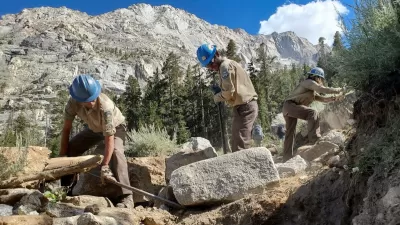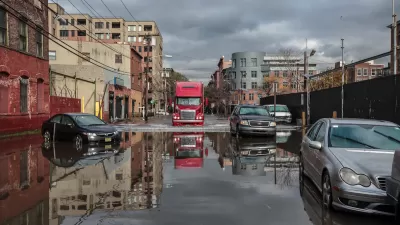A new federal initiative places young workers in jobs aimed at building climate resilience, but will it avoid the mistakes of similar programs?

A new federal program titled the American Climate Corps (ACC) models itself on the Depression-era Civilian Conservation Corps (CCC), which created tens of thousands of jobs and built thousands of small and large infrastructure projects around the country.
The ACC will focus on climate resilience, explains Brooke Larsen in High Country News. “The jobs they do will vary, from wildland firefighters and “lawn busters” to urban farm fellows and traditional ecological knowledge stewards. Some will work on food security or energy conservation in cities, while others will tackle invasive species and stream restoration on public land.” The positions available are generally staffed through state and local non-profits that partner with federal agencies. “In New Mexico, for example, members of Conservation Legacy’s Ecological Monitoring Crew will help the Bureau of Land Management collect soil and vegetation data.”
Larsen notes that “AmeriCorps and conservation corps programs have been criticized for offering low wages and few benefits” and excluding people of color and low-income communities. “While the administration aims for all positions to pay at least $15 an hour, the lowest-paid position in the West is currently listed at $11 an hour. Benefits also vary widely, though most include an education benefit, and, in some cases, health care, child care and housing.”
FULL STORY: The American Climate Corps take flight, with most jobs based in the West

Trump Administration Could Effectively End Housing Voucher Program
Federal officials are eyeing major cuts to the Section 8 program that helps millions of low-income households pay rent.

Planetizen Federal Action Tracker
A weekly monitor of how Trump’s orders and actions are impacting planners and planning in America.

The 120 Year Old Tiny Home Villages That Sheltered San Francisco’s Earthquake Refugees
More than a century ago, San Francisco mobilized to house thousands of residents displaced by the 1906 earthquake. Could their strategy offer a model for the present?

HSR Reaches Key Settlement in Northern California City
The state’s high-speed rail authority reached an agreement with Millbrae, a key city on the train’s proposed route to San Francisco.

Washington State Legislature Passes Parking Reform Bill
A bill that would limit parking requirements for new developments is headed to the governor’s desk.

Missouri Law Would Ban Protections for Housing Voucher Users
A state law seeks to overturn source-of-income discrimination bans passed by several Missouri cities.
Urban Design for Planners 1: Software Tools
This six-course series explores essential urban design concepts using open source software and equips planners with the tools they need to participate fully in the urban design process.
Planning for Universal Design
Learn the tools for implementing Universal Design in planning regulations.
Ada County Highway District
Clanton & Associates, Inc.
Jessamine County Fiscal Court
Institute for Housing and Urban Development Studies (IHS)
City of Grandview
Harvard GSD Executive Education
Toledo-Lucas County Plan Commissions
Salt Lake City
NYU Wagner Graduate School of Public Service





























